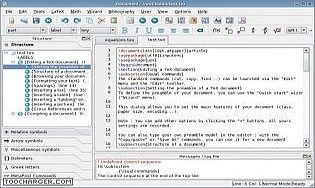
# include one of the basic flavours (cua or emacs) You may wish to change this to F8 by creating a new bind-file, say $HOME/.lyx/bind/myShortcuts.bind and include one of the standard files, e.g.: xml file for your language.īy default, the short-cut for buffer-chktex is M-e h (e.g Alt-e then h). You may also be able to customize JLanguageTool error rule by editing JLanguageTool's. WORD_REPEAT_RULE) find ignore_rules=( in add the error name to it. To disable a chktex rule (error # < 666) find where we call /usr/bin/chktex and add -n99 to the command line, where 99 is the number of the rule to disable. To customize or remove an inernally generated error, (error #666) you will have to find ErrorTypes=( in and edit the ErrorTypes array.

If this is not the case, replace /usr/bin/chktex with the actual path of chktex in the file .Īt present to customize LyX-GC you have to edit. The LyX-GC script assumes that chktex is installed in /usr/bin/chktex. An error notification should appear after the second activation. To check that it is set up correctly enter "is were" into a new file and activate Check Tex twice (In LyX 1.4 Check Tex is in the Tools menu, prior to 1.4 it was in the Edit menu).
Texmaker grammarly full#
To enable use of JLanguageTool, you will have to change. so that JAVA equals the full name and path of the official Sun Java 1.4 binary, and LANGUAGETOOL_PATH equals the path of JLanguageTool. I have not tested this script under Windows, but it should just work if you are using Cygwin.
Texmaker grammarly for mac os#
For Mac OS X, you may have to change the LYX variable in the chktex wrapper in the lyx-gc-0.3d directory. no setup should be required to detect errors such as "An person").

No database is required.No configuration should be required for basic use under Linux (e.g. That is, a representation of text that can store deletions, find diffs, undo deletions, and move a diff accordingly? If not in Haskell, does something like this exist somewhere else?īonus question 2: What is the simplest (as in loc required) web framework in Haskell to set up such a web app? It would serve one HTML document and accept updated versions of the text files. In Haskell, is there a data structure for text editing that supports this use case. Presuming that the removal of formatting can be implemented by only deleting content, it should be possible to take a correction as a diff and reapply it to the formatted document. But the process of editing needs some thought. While it is reasonably simple to create such a web application, there are other requirements to be considered: LaTeX parsing (up to "standard" syntax) and a library like HaTeX could deal with parsing and interpretation. The app would have to take the corrected text and reapply formatting, markdown, etc. The user could open that document, run Grammarly, and apply any fixes. tex sources, remove all formatting and markup, and expose the files as an HTML document. To that end, a simple web app could walk through a directory, read all. It suffices to provide a convenient interface to check multiple source files at once. In principle, it is not necessary to support Grammarly directly in, e.g., emacs. I also presume that other solutions exist or will soon pop up that work similarly. I guess many people could use that tool when writing up scientific papers or pretty much any other LaTeX tool.

Grammarly is apparently often confused when forced to deal with annotated text or text that is formatted (e.g. Currently, there neither exists support for text editors nor latex sources. Grammarly is an online app that provides grammar and spell-checking as a browser plugin. Let me start with acknowledging that this is a rather broad question, but I need to start somewhere and reduce the design space a bit.


 0 kommentar(er)
0 kommentar(er)
